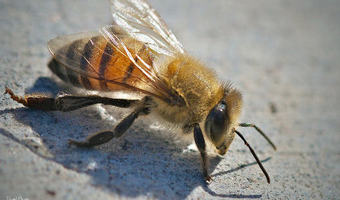 Deforestation and climate change are driving African honey bee to extinction contrary to popular belief that synthetic chemicals are according to scientists. The possible extinction would deal a major blow to food security as bees pollinate almost all the crop species that feed the global population.
Deforestation and climate change are driving African honey bee to extinction contrary to popular belief that synthetic chemicals are according to scientists. The possible extinction would deal a major blow to food security as bees pollinate almost all the crop species that feed the global population.
According to the UN Food and Agriculture Organization (FAO), of the slightly more than 100 crop species that provide 90 percent of food worldwide, bees pollinate 71. Some crops that depend on honeybees would see more than a 90 percent reduction in yield without honey bees. Although estimates vary, the global value of insect pollination services provided for the most part by honey bees was recently placed at $US 212 billion worldwide, equivalent to just under 10 percent of total food production for human consumption.
The new revelation was made public by scientists from Pennsylvania State University Center for Pollinator Research, and International Centre of Insect Physiology and Ecology ICIPE through their study published in the scientific journal PLOS ONE. Previously, it has been widely publicized that the introduction of agro chemical usage in Africa was solely responsible for the now notorious honey bee colony collapse diseases and many campaigns had been initiated to enhance honey bee preservation through restriction of agro chemical usage.
According to the joint study, African honey bees remain unaffected by a number of diseases that have been linked to significant colony losses in the United States and Europe, raising the prospect that African honey bees may possess ‘novel resistance mechanisms’ to disease that warrant further investigation. “Our studies suggest that honey bee populations in East Africa appear to be largely resistant or tolerant of the parasites and pathogens that threaten honey bee populations in other parts of the world, and are not yet significantly impacted by other stressors, such as exposure to environmental toxins,” the researchers state.
In fact, the study notes, while more than 90 percent of honey bee colonies in the United States contain pesticide residues, only four chemical pesticides were detected in the colonies sampled for this study, and at trace levels that would be considered negligible. “Over 129 different pesticide-related chemicals have been found in US bee colonies, with an average of 6 chemicals per colony,” the study states.
“The low level of pesticides in hives from across Kenya, particularly when compared to levels in developed countries, suggests pesticide residues play only a limited role in honey bee health in Kenya at this time.”
This preliminary data suggest that bee population declines in East Africa could be tied instead to loss of habitat and deforestation, as cities expand and previously primary habitat is converted into agricultural or other uses, rather than the declines’ being related to bee pests and diseases. In addition, increasingly frequent drought conditions and climate change could be having an impact. If the availability of flowering plants is reduced by any of these factors, that means less food available to bees. Also, with shifts in land cover, bees might not be able to travel longer distances to food sources and back to the hive if, for example, vast fields of wild flowers disappear. The same would hold true if sources of water within the surrounding area were reduced.
“Honey bees pollinate many food crops as well as those important for economic development, and their products, like honey and wax, are vital to the livelihood of many families. People say the greatest animal in Africa is the lion or the elephant, but honey bees are more essential, and their decline would have profound impacts across the continent,” said Harland Patch, research scientist in entomology at Penn State.
According to the UN Food and Agriculture Organization (FAO), of the slightly more than 100 crop species that provide 90 percent of food worldwide, bees pollinate 71. Some crops that depend on honeybees would see more than a 90 percent reduction in yield without honey bees. Although estimates vary, the global value of insect pollination services provided for the most part by honey bees was recently placed at $US 212 billion worldwide, equivalent to just under 10 percent of total food production for human consumption.
Write comment (0 Comments)














